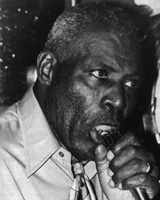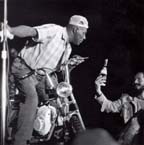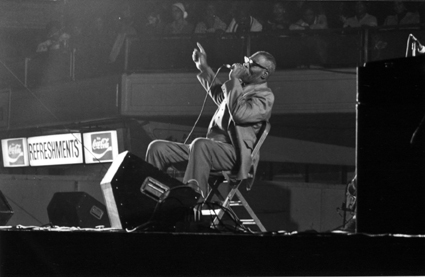_tmnl.jpg)


|
In his later years, Wolf continued to perform with a manic intensity
that would’ve exhausted a man half his age, often in small clubs that
other well-known bluesmen had already abandoned. Wolf said simply, “I
sing for the people.”
In 1964, Wolf also married his long-time sweetheart,
Lillie
Handley, whom he had met in 1957 at Silvio’s
nightclub in Chicago. Wolf called
Lillie “a
flower from the first day I met her,” and he doted on
her two daughters, Bettye Jean and Barbra. Despite his
wild antics onstage, Wolf was a responsible,
middle-class family man offstage—honest, hardworking,
and upstanding to a fault. He hunted and fished, owned
farmland in Arkansas, volunteered with the local fire
department, and was a proud member of the local chapter
of the Masons.
Wolf’s collaborator on many of his greatest songs
was guitar wizard
Hubert Sumlin, who played
electric guitar with his bare fingers instead of using a pick. Hubert's eccentric, slashing style made
him a favorite of Eric Clapton, Jimmy Page, Stevie Ray Vaughan, Jimi
Hendrix, Peter Green, and many other guitarists from the 1960s onward.
During the 1960s, Wolf and
Hubert
continued to record sizzling blues that anticipated blues-rock—classic
songs such as “Commit
a Crime,” “Hidden Charms,” and “Love Me,
Darlin’” In 1964, he toured Europe, including
the U.K. and even Eastern Europe, with the American Blues Festival. In
1965, he appeared on the American television show “Shindig” with the Rolling Stones. In 1970 he recorded
The London Howlin’ Wolf Sessions in England with
Eric Clapton, members of the Rolling Stones, and other
British rock stars. It was his best-selling album,
reaching #79 on the pop charts.
|
_tmnl.jpg)
|
Not bad for a 60-year-old man—a very ill one. In the
late 1960s and 1970s, Wolf suffered several heart attacks, and his kidneys
began to fail him. For the rest of his life, he received
dialysis treatments every three days, administered by
Lillie. Despite his failing health, Howlin’ Wolf
stoically continued to record and perform. In 1972 he
recorded a live album at a Chicago club, “Live and Cookin’ at Alice’s Revisited.” In 1973, he cut his last
studio album, “Back Door Wolf” which included the
incendiary “Coon on the Moon,” the autobiographical “Moving,” and “Can’t Stay Here,” which harked back to
Charley Patton.
|
 |
Wolf’s last performance was in November 1975 at the
Chicago Amphitheater. On a bill with
B.B. King, Albert
King, O. V. Wright, Luther Allison, and many other great
bluesmen, Wolf gave a heroic performance, rising almost
literally from his deathbed to recreate many of his old
songs and performing some of his old antics such as
crawling across the stage during the song “Crawling King
Snake.” The crowd went wild and gave him a five-minute
standing ovation. When
he got offstage, a team of paramedics where called in
to revive him. Two months later he died in Chicago during an operation for a
brain tumor. He was buried in
Hines, IL.
|

|
Wolf was inducted into the Blues Foundation’s Hall of Fame in
1980 and the Rock & Roll Hall of Fame in 1991. There will never be another Howlin’ Wolf. His
biographers, Jim
Segrest and
Mark Hoffman, believe he was the most
exciting singer and performer in the history of blues
music. Many blues experts we’ve talked with agree with
that assessment. As one blues critic put it, “If you want to know what stage
presence is, just point at Howlin’ Wolf and divide by ten!” |
|
|
![]()